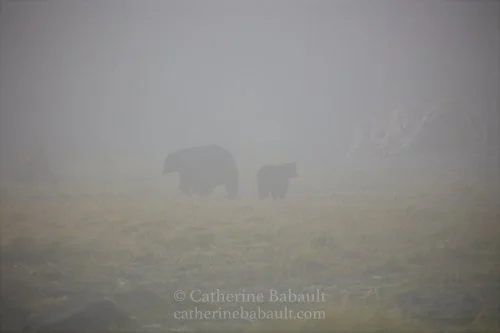As a wildlife photographer, I enjoy learning about wild animals and observing them in their natural environment. While some photographers are interested in birds, I prefer mammals. Big mammals, like bears. Their large size, curvy shape and thick fur make them both attractive and intimidating.
I saw my first black bear in Manitoba during a solo road-trip across the country. I was driving on a rural road when suddenly a chunky bear crossed the road and dashed into the woods. It was a brief encounter but I was delighted. After settling on Vancouver Island, I became aware that bears are everywhere. They frequent the mountains, coastal rainforests and towns. I also learnt that black bears can swim, climb trees, and break into homes and vehicles. I had moved to bear country.
After learning about bear safety, my next step was to capture their natural behaviour in their natural habitat. However, I had to find the right balance between reaching my goal and minimizing my impact on the animals, which meant I had to keep a safe distance and avoid disrupting their activities. The other factors I had to consider were the location and accessibility, the time of the year, the light, and the setting. After spending an extensive period of time researching at home and exploring in the field, I found a remote prime fishing spot used by black bears during the salmon run. By the time I first visited that spot, I had encountered many black bears around Vancouver Island, so I was familiar with their behaviour and I knew how to read their body language.
Mama bear and her cub on a foggy morning, Vancouver Island, British Columbia.
One morning, when I arrived at that fishing spot, it was entirely wrapped in thick fog and the visibility was greatly reduced. I could see dark rounded shapes here and there on the shoreline, but I could only determine whether it was a bear or a big boulder when it started to move. It was a surreal experience. One by one, bears came out of the rainforest and nonchalantly walked to a pool of water filled with salmon. Once they caught a fish, they walked back to the forest where they ate their tasty meal in peace. They mostly came alone but sometimes a mother bear was accompanied by her cubs. The time passed slowly as I waited for them to appear and disappear through the dense fog. I felt privileged to be in the presence of such an incredible animal.
A coastal black bear during the salmon run on Vancouver Island, British Columbia.
There were other extraordinary moments. One day, I watched a teenage bear challenging authority. He reminded me as a teenager. He wanted access to the best fishing spot but a dominant sow was already there. Determined to get a salmon, he approached the spot knowing perfectly well that he was challenging her dominant place in the hierarchy. She ignored him so the intrepid yearling decided to get even closer. Annoyed by his persistence, she got up and briefly chased him. Startled, he ran away but he had forgotten where I was and he was coming towards me. So I had to tell him to back off in a stern voice. Surprised to find me in his way, he stopped, turned around and walked away.
I like observing the different characters in animals, especially bears. Some are shy, others are bold and curious. They are not that different from us. I have witnessed cubs fighting over a big salmon their mother had caught for them. At only a few months old, they were already demonstrating distinctive traits.
There are more stories like these in my book Wild Vancouver Island. It features several species such as Roosevelt elk, Vancouver Island marmots, sea otters, humpback whales and many other mammal and bird species. Working as a wildlife photographer has its challenges but it is also rewarding. When I have the privilege of having a glimpse into the lives of wild animals in their natural environment, I tend to forget all the time I spent waiting for them in the rain, fog or cold. Every year, I look forward to the salmon run and my trip to that special place, where I can spend days watching and photographing the coastal black bear.


